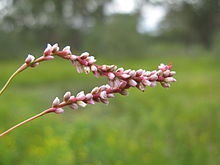Persicaria decipiens
| Persicaria decipiens | |
|---|---|

| |
| Scientific classification | |
| Kingdom: | Plantae |
| Clade: | Tracheophytes |
| Clade: | Angiosperms |
| Clade: | Eudicots |
| Order: | Caryophyllales |
| Family: | Polygonaceae |
| Genus: | Persicaria |
| Species: | P. decipiens
|
| Binomial name | |
| Persicaria decipiens | |
| Synonyms[1] | |
|
List
| |
Persicaria decipiens, commonly known as slender knotweed, is a species of flowering plant native to Australia and Asia.[2]
Persicaria decipiens is a trailing plant whose stems grow horizontally at first but become more vertical with time,[3] reaching 30 cm (1 ft) high. Its narrow elliptic to lanceolate (spear-shaped) leaves are 5–12 cm (2–4.5 in) long and 0.5–1.3 cm (0.20–0.51 in) across.[2] The slender pink flower spikes appear from November to June, with a peak in February.[3] Cylindrical in shape, they are not stiff and tend to bend over.[2] The plant tends to die back in winter and regenerate after water.[3]
Persicaria decipiens was among the plants collected by Joseph Banks and Daniel Solander on 5 May 1770 at Botany Bay during the first voyage of Captain James Cook.[4] Prolific Scottish botanist Robert Brown described the species as Polygonum decipiens in his 1810 work Prodromus Florae Novae Hollandiae et Insulae Van Diemen.[5] It was given its current name by Karen Wilson in 1988 as the broadly defined genus Polygonum was split into smaller genera.[4] Common names include slender knotweed, willow weed and snake root.[6]

P. decipiens is found in water and wet soil. It is found across Africa and the Mediterranean,[6] through southwestern Asia, Malesia and all states of Australia, as well as Norfolk Island, New Zealand and New Caledonia.[2] It has become naturalised in Madagascar.[6]
Likely pollinators of its flowers are insects, including honeybees, native bees, flies, wasps and small butterflies.[3]
Persicaria decipiens is not cultivated but is eaten locally in times of famine in Africa.[6]
References[edit]
- ^ "Persicaria decipiens (R.Br.) K.L.Wilson". Plants of the World Online. Board of Trustees of the Royal Botanic Gardens, Kew. 2017. Retrieved 23 December 2020.
- ^ a b c d Wilson, K.L. "New South Wales Flora Online: Persicaria decipiens". Royal Botanic Gardens & Domain Trust, Sydney, Australia.
- ^ a b c d Benson, Doug; McDougall, Lyn (1999). "Ecology of Sydney Plant Species Part 7a: Dicotyledon families Nyctaginaceae to Primulaceae" (PDF). Cunninghamia. 6 (2): 402–508 [484]. Archived from the original (PDF) on 2016-03-13.
- ^ a b Wilson, Karen L. (1988). "Polygonum sensu lato (Polygonaceae) in Australia". Telopea. 3 (2): 177–82. doi:10.7751/telopea19884806.
- ^ Brown, Robert (1810). Prodromus Florae Novae Hollandiae et Insulae Van Diemen (in Latin). London, United Kingdom: Richard Taylor and Company. p. 420.
- ^ a b c d Grubben, G. J. H. (2004). Vegetables. Plant Resources of Tropical Africa. Vol. 2. PROTA. pp. 413–14. ISBN 9789057821479.
